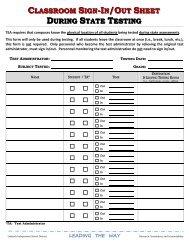Guidelines for Co-Teaching in Texas - Region 17
Guidelines for Co-Teaching in Texas - Region 17
Guidelines for Co-Teaching in Texas - Region 17
You also want an ePaper? Increase the reach of your titles
YUMPU automatically turns print PDFs into web optimized ePapers that Google loves.
<strong>Co</strong>nsiderations <strong>for</strong> Schedul<strong>in</strong>gThere are three major schedul<strong>in</strong>g considerations <strong>in</strong> plann<strong>in</strong>g a campusco-teach<strong>in</strong>g environment:1) campus master schedule,2) teacher plann<strong>in</strong>g time, and3) student schedules.1 Campus Master ScheduleFor successful co-teach<strong>in</strong>g implementation, there are several th<strong>in</strong>gs that the campus master schedulerneeds to take <strong>in</strong>to account. <strong>Co</strong>-teach<strong>in</strong>g classes must be on equal foot<strong>in</strong>g as other courses <strong>in</strong> developmentof the master schedule, with thoughtful placement of co-teach<strong>in</strong>g classes with<strong>in</strong> the master schedule to meetboth teachers’ and students’ needs.The campus master schedule must consider schedul<strong>in</strong>g of teachers and not just classes. If co-teachersmove from one room to another to work <strong>in</strong> multiple classrooms, proximity of the co-teach<strong>in</strong>g classroomsmust allow timely navigation, especially if the co-teacher has materials to transport from one classroom toanother. Also, the level of support needed <strong>for</strong> each <strong>in</strong>dividual student, <strong>in</strong>clud<strong>in</strong>g varied amounts of time andflexibility of chang<strong>in</strong>g needs dur<strong>in</strong>g the year, must be considered when prepar<strong>in</strong>g the schedule. If studentsreceiv<strong>in</strong>g support have IEPs that require specific contact time, the times noted on the IEP must be honored.At different grade levels, teacher teams are organized differently. For example, at elementary school,teams are often organized by grade level; at the secondary level, it is often by content area. One simpleand effective co-teach<strong>in</strong>g model assigns the special education co-teacher to a team the same way generaleducators are assigned to teams. This method of team assignment assists <strong>in</strong> schedul<strong>in</strong>g plann<strong>in</strong>g time andcoord<strong>in</strong>at<strong>in</strong>g teachers’ work. It also permits flexibility <strong>for</strong> the special education co-teacher who will, mostlikely, be collaborat<strong>in</strong>g with more than one general educator. Another consideration <strong>for</strong> team assignments isthe content area strengths of each co-teacher.Schedul<strong>in</strong>g ARDs and substitute teachers is an additional issue <strong>for</strong> campus master schedulers to consider.Neither general nor special education co-teachers should be pulled from their co-teach<strong>in</strong>g sett<strong>in</strong>gs <strong>in</strong> orderto attend ARDs or to act as substitute teachers <strong>in</strong> other classrooms. This is especially true when a student’sIEP requires <strong>in</strong>clusive services and these services are delivered through a co-teach<strong>in</strong>g model; failure toprovide the IEP-required <strong>in</strong>clusive services could result <strong>in</strong> a student’s IEP not be<strong>in</strong>g implemented as written,a non-compliance issue. For co-teach<strong>in</strong>g to be truly successful, co-teachers must have time actually to be <strong>in</strong>the classroom and work with students.© <strong>Texas</strong> Education Agency / Education Service Center, <strong>Region</strong> 20 <strong>Texas</strong> <strong>Co</strong>-<strong>Teach<strong>in</strong>g</strong> <strong>Guidel<strong>in</strong>es</strong> | 25
















